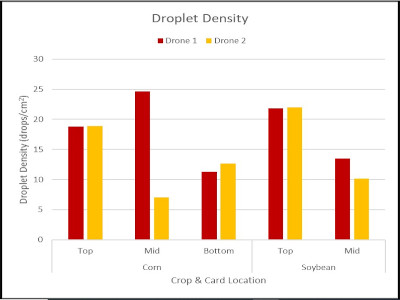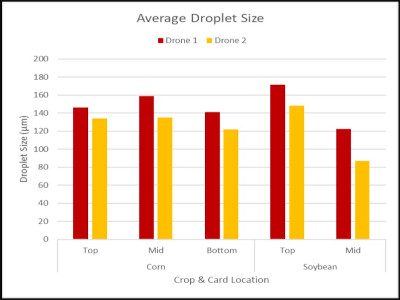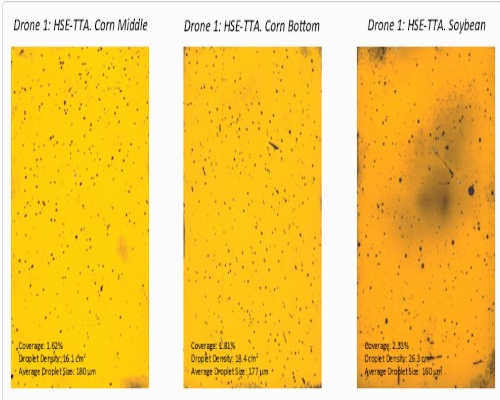The drones were operated by certified pilots who offer custom pesticide application in field crop and nurseries. Weather conditions were sunny and 91°F with variable winds out of the Northeast at 5 mph, gusting to 25 mph.
Prior to spraying, water-sensitive cards (Syngenta AG®, Basel, Switzerland) were placed within the crop canopy at various heights in sets of five replicates. Three heights were used for both corn (top: third leaf from tassel; middle: ear leaf; and bottom: third leaf from bottom) and soybean (top: upper most fully expanded leaf; mid: middle of canopy; and bottom; 1 foot up from soil). When water droplets hit the card, the card arrests the spread of the droplet and stains the card blue. The cards were retrieved then scanned into the computer and analyzed using the software DepositScan (USDA-ARS, Wooster, OH), which calculates percent spray coverage, droplet density, and droplet size.
Each drone applicator flew on water at approximately 4 feet above the canopy at 16 mph onto corn and soybeans at a rate of 1 gallon per acre for Drone 1 and 1.5 gallons per acre for Drone 2 using TeeJet® TXA8002VK nozzles.
Results & Discussion
Due to the extremely high humidity, close canopy, and transpiration rate of the soybean plants, the middle and bottom spray cards in the soybean plots were difficult to read. As a result, data for bottom soybean cards were omitted.
As to be expected, spray coverage was highest in the top of the canopy for both corn and soybean for both drones (Figure 2). Drone 1 achieved 1.61% and 2.40% coverage in the top canopy of corn and soybean respectively. Drone 2 also achieved greater coverage in the top canopy of soybean (1.50%) than corn (1.10%). Both drones delivered nearly identical droplet density (Figure 3) in the top canopy of both corn (18.9 drops/cm2) and soybean (22.0 drops/cm2). Droplet size (Figure 4) in the top canopy of corn for Drone 1 was 146 µm vs. 134 µm for Drone 2 and 171 µm for Drone 1 vs 148 µm for Drone 2 in soybean top canopy.

Figure 2. Average percent spray coverage for water sensitive spray cards placed in the top, middle, and bottom canopy of corn and soybean for two drones.

Figure 3. Average droplet density on water sensitive spray cards placed in the top, middle, and bottom canopy of corn and soybean for two drones.
Spray coverage dropped only slightly for Drone 1 (to 1.57%) in corn from top to middle, but much more in soybean (down to 0.68%), likely due to the dense canopy. Coverage dropped to 0.42% for Drone 2 at the ear leaf in corn and down to 0.20% in the mid canopy soybean. Drone 1 achieved 21.65 drops/cm2 for the ear leaf in corn whereas Drone 2 delivered 7.00 drops/cm2. In mid canopy soybean, droplet density was similar for both drones (13.5 drops/cm2 for Drone 1 and 10.17 drops/cm2 for Drone 2). Droplet size for both drones were similar between top, middle, and bottom corn. Droplet size decreased for both drones in middle canopy soybean to 122 µm for Drone 1 and 87 µm for Drone 2.

Figure 4. Average droplet size for Drones 1 and 2 on water sensitive spray cards placed in the top, middle, and bottom canopy of corn and soybean.
Spray coverage and droplet density were similar for both drones in bottom canopy corn. Spray cards for bottom canopy soybeans were not analyzed due to artifacts created by canopy humidity.
It is generally recommended that droplet density should be between 20-30 droplets/cm2 for adequate insecticide application, between 20-40 droplets/cm2 for herbicide application, and at least 50 droplets/cm2 for fungicide applications. Based on these assumptions, both Drones have the capability to deliver densities at or over 20 droplets/cm2 in the upper canopy, which may be adequate for herbicide or insecticide applications. However, a greater density of droplets needs to be achieved for adequate fungicide application. Previous research has shown that flight velocity plays a significant role in droplet density and spray coverage (Hunter III et. al., 2020). Spraying slower would likely improve coverage and efficacy of fungicides applied via drones, which will be an area of future research for this project.
Example Spray Card Images


Source : umd.edu